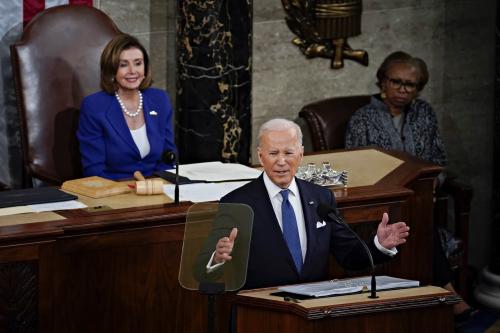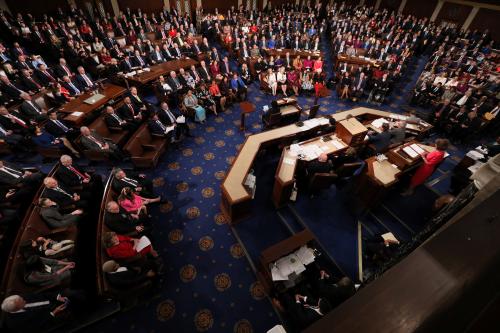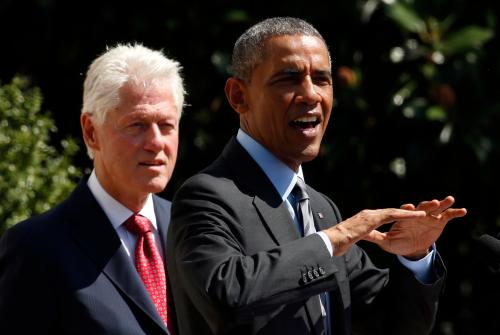This post is part of series by Brookings experts on Trump’s 1st State of the Union.
Tonight the nation will turn its attention to an annual ritual that, like American politics itself, runs the gamut from inspiring to ridiculous—the State of the Union.
The State of the Union was originally called the Annual Message. Although President George Washington gave the first one in person before Congress in 1790, Thomas Jefferson decided to mail it in. The message was delivered in writing until the early part of the 20th Century—at which point President Woodrow Wilson revived the tradition that has lasted until today. Along the way the State of the Union went from radio to television to the Internet and picked up a formal response from the political party out of power. While the State of the Union has provided us with some of our most uplifting and sublime moments, the various responses have also provided ample fodder for late-night comedians.
Let’s start with the sublime. Consider, for instance, Franklin Roosevelt’s 1941 State of the Union in which he evoked “the Four Freedoms”—freedom of speech and worship and freedom from want and fear—as a powerful justification for what was to be America’s role in a world at war.
Then there was Lyndon Johnson’s declaration in his 1964 State of the Union that the coming Congress would be remembered as the one that “declared all-out war on human poverty.”
More recently, in his 2002 State of the Union address following the 9/11 disaster, President George W. Bush rallied the nation and declared North Korea, Iran and Iraq “the axis of evil.”
It was President Ronald Reagan who began the tradition of seating a worthy American in the balcony next to the First Lady in order to make a point. In 1982 he invited Lenny Skutnik, a hero of a plane crash in the Potomac and said of him—“Just two weeks ago, in the midst of a terrible tragedy on the Potomac, we saw again the spirit of American heroism at its finest the heroism of dedicated rescue workers saving crash victims from icy waters. And we saw the heroism of one of our young Government employees, Lenny Skutnik, who, when he saw a woman lose her grip on the helicopter line, dived into the water and dragged her to safety.”
Fourteen years later Bill Clinton, delivering his remarks after a government shutdown, introduced another hero to America. This year President Trump’s speech writers might want to pay some special attention to the political jujitsu Clinton pulled off that night. He introduced Richard Dean as follows:
“He is a 49 year-old Vietnam veteran who’s worked for the Social Security Administration for 22 years now. Last year he was hard at work in the Federal Building in Oklahoma City when the blast killed 169 people and brought the rubble down all around him. He reentered that building four times. He saved the lives of three women. He’s here with us this evening, and I want to recognize Richard and applaud both his public service and his extraordinary personal heroism. But Richard Dean’s story doesn’t end there. This last November, he was forced out of his office when the government shut down. And the second time the government shut down he continued helping Social Security recipients, but he was working without pay. On behalf of Richard Dean and his family, and all the other people who are out there working every day doing a good job for the American people, I challenge all of you in this Chamber: Never, ever shut the federal government down again.”
While most State of the Union addresses are uplifting, well-orchestrated and assert, whether true or not, that the state of the union is sound, in President Gerald Ford’s 1975 State of the Union stands out for the fact that he departed from this script to declare “The state of the union is not good.”
Other State of the Union addresses give an opening, intended or not, into the President’s state of mind. In Barack Obama’s last State of the Union he took on some responsibility for the ugliness that had come to grip politics in Washington during his time in office and mused that “it’s one of the few regrets of my presidency—that the rancor and suspicion between the parties has gotten worse instead of better.”
Richard Nixon’s last state of the union took place in 1974 under pressure from the Watergate investigation that had already put several of his associates behind bars and that would lead to his resignation from office that following summer—just ahead of sure votes to impeach and convict him. In this clip he is talking about welfare reform but instead of saying “we must replace the discredited present welfare system,” he said “we must replace the discredited president … present.” By that point he surely knew that his presidency had been discredited.
Most of the time the State of the Union is well-scripted and carefully produced. The same cannot be said of the responses. In recent years the responses have been, well, less than sublime.
In response to Ronald Reagan’s 1985 State of the Union, the Democrats ran a ten-minute tape featuring Democratic elected officials talking to citizens in focus groups. In between the segments, a young Governor Bill Clinton told the country “clearly there’s a Democratic Party in America that’s alive and well.” After the Republican landslide in 1984—the entire Democratic response, awkward and hard to watch, (especially the average Americans saying that they were, indeed, better off under Reagan)—did not manage to convince anyone that the Democratic Party was alive and well.
Republicans have had their own response debacles. Often the person chosen to deliver the Party’s response is a rising star—at the time. The rising star chosen to respond to President Obama’s 2010 State of the Union was Virginia Governor Bob McDonnell—who was convicted of corruption shortly thereafter.
And then there are the embarrassing screw-ups that provide fodder for Saturday Night Live’s opening sketches. In response to the 2011 State of the Union, the Republicans offered two responses, one of them from the Tea Party. Michele Bachmann was chosen to give it and delivered the entire address looking at the wrong camera. A few days later comedienne Kristin Wiig did a parody of “crazy eyes” Bachmann on SNL. It’s probably safe to say that the parody was seen by more people than was the original response.
But if the official responses have been less than stellar the unofficial ones have sometimes been downright bizarre. Take the case of Congressman Michael Grimm who was, like many of his colleagues, hanging out on the balcony of the Cannon House office building after the 2015 State of the Union. NY1 Reporter Michael Scotto asked him about the State of the Union and then followed up with a question about the Congressman’s campaign finance irregularities. Grimm refuses to answer, walks away and then, with the camera still running tells the reporter “…if you ever do that to me again I’ll throw you off this f—— balcony.” Grimm is no longer in Congress; although in the upside-down world of our current politics Grimm is currently seeking his old seat now that he has been released from federal prison.
So, there you have it. From the four freedoms to threats of violence. The State of the Union is just like the country it’s about.








Commentary
Trump’s 1st State of the Union: A rundown of the best and worst in history
January 30, 2018